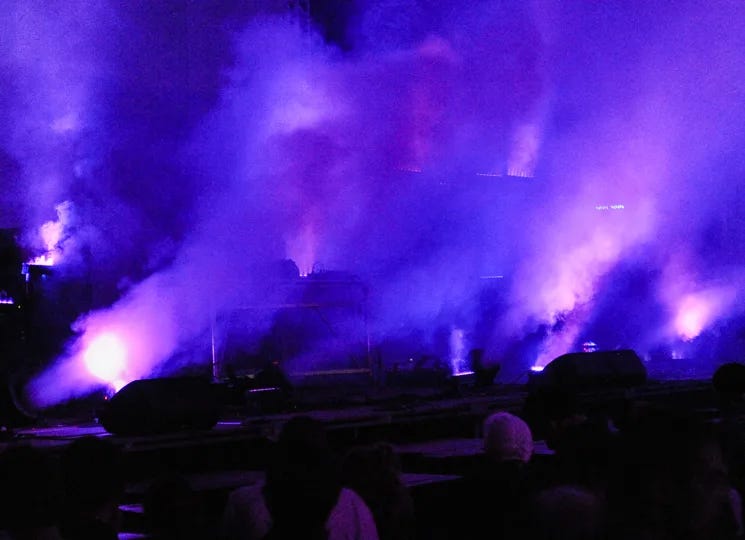Cantilever is a regular rundown of upcoming London-based gigs and other musical ephemera. Subscribe to receive these updates directly in your inbox!
This week’s playlist
Featuring multiple artists playing “FIGURA presents Seeing in Dreams” this weekend (discussed below) and more besides:
Tim Hecker — HERE at Outernet, 09.05.2025
Live, Tim Hecker is fantastically loud. His brand of electronic composition - a warp and weft of overlapping ambience - is cranked up to the limit of the bearable, where sound isn’t so much heard as it is felt or experienced. It is, for some, just too much.
It is important to note, however, that in these performances loudness is not a gimmick, nor a kind of sonic bravado. Hecker has studied the implications of extreme volume extensively and wrote a PhD thesis on the “megaphonic” in the long 19th century, taking the word — which essentially means anything extremely loud — from a short but frenetic essay by literary critic Steven Connor, who said:
“Noise forces hearing to spill across into the other senses: we do not merely apprehend noise, we undergo it; shaken and scattered, we become ourselves noised, or noisy. We start to hear with our skin and skull and teeth. Noise is the jeopardy of the ego.”
Jeopardising the ego is chief among Hecker’s concerns. In his thesis, he writes about “moments of liquidation of the self, of the dissolution of ego, or of bone-rattling de-subjectivation” emergent from the megaphonic.
Both Hecker and Connor’s statements of this kind are effectively a contemporary spin on the Romantic concept of The Sublime. In Edmund Burke’s landmark 1757 treatise on the concept — A Philosophical Enquiry into the Origin of Our Ideas of the Sublime and Beautiful — he variously discusses the “greatness of dimension” that makes the human being feel small, awestruck and moved, be it in a landscape, or other inhuman scene. When it comes to sound, Burke said this:
“Excessive loudness alone is sufficient to overpower the soul, to suspend its action, and to fill it with terror. The noise of vast cataracts, raging storms, thunder, or artillery, awakes a great and awful sensation in the mind, though we can observe no nicety or artifice in those sorts of music.”
This last point of Burke’s helps provide the key to Hecker’s music, who consistently asks what might happen if “nicety or artifice” were, in fact, combined with the overwhelming invisible forces of The Sublime. In recorded music of course, there really is a limit to the loud. A good deal of “artifice” is therefore necessary to achieve the desired effect.
Accordingly, Hecker is at his best when he takes a set of organic tones and contrasts them with something more clearly immense and synthetic. For example, the piano on the closing section of Ravedeath 1972 (2011), or follow up Dropped Pianos (2011), a chorus of voices on Love Steams (2016), and a Japanese Gagaku ensemble on Konoyo (2018) and Anoyo (2019), placing these tones in contrast with waves of feedback, distortion and looping ambience. The sublime machine — intimating a kind of enormous invisible force — is placed against a very human musical language that appears small, delicate and vulnerable in comparison, often becoming enveloped in or overwhelmed by the all-encompassing synthesis of sound.
In Hecker’s music of this kind, we hear an effect of scale that goes back to some the real classics of Sublime art. See, for instance, J.W.M Turner’s Rain Steam and Speed (1844) where the new technology (the steam train), hurtles towards the viewer in a picturesque landscape. The older technology — the boat with a figure in it, beneath and to the left — pales in comparison to the scale of the coming wave, pushing us into an uncertain future.
To achieve the full Sublime effect, when Hecker plays live, an enormous sea of fog is pumped into the space through haze machines, making the entire venue appear like a Turner painting, obscuring the figures inside as they succumb to the music of machines. At the end, when you watch Tim Hecker, you witness a rare near-perfect synthesis of concept and execution.
Hecker rarely plays in London, so this is a good chance to see if what I have said here (true of his last forays) is consistent. Given all of the above, though, I would remind any prospective audiences to bring ear protection. Your hearing is a gift and should be looked after!
Horse Vision — HERE at Outernet, 10.05.2025
Stockholm’s Horse Vision are the latest in a run of contemporary artists to deftly interpolate, rather than simply perform, a certain kind of musical sincerity.
For example, here is Horse Vision’s recent single ‘Chemicals’:
And here’s American band Freelance Whales’ track ‘Starring’ from 2008:
The choruses are remarkably sonically similar, there’s something “cute” or whimsical about both melodies, the sonic palette is at least significantly echoed. And yet Freelance Whales could easily be decried as a pre-eminently parodiable example of turn of the 2010s Brooklynite hipsterism: the “hey!” choruses, the banjos, the glockenspiels, the embroidery on the cover, the heartfelt earnestness of the whole thing.
Horse Vision, on the other hand, are released by conceptual record label “indadvertent.index”, whose first release (a mix tape) is self-referentially titled “Guitar Music” - featuring shoegaze, dream pop, cyberfolk with a digital sheen - and whose website links off to various obscure philosophical or conceptual areas of interest. It’s a more self-aware music, shot through with a kind of post-internet literacy. Very much of the moment.
00s electro-folk is clearly present on Horse Vision’s Another Life (2025), but it’s far from the only influence woven in. The extremely dry and close guitars on ‘Segundi Garinasso’ sound uncannily close to slowcore band Duster’s album Stratosphere (1998). There are also samples from electro-pop in The Knife (‘Heartbeats’) and M.I.A (‘Bad Girls’) that creep into the record, making a kind of patchwork or bricolage effect, echoing, at the level of the album, our contemporary playlist culture in which many different sounds from different musical sources may be united in, reigning term of the moment: “vibe”.
Like P.C Music head honcho A.G Cook’s statements on his love of pop music, I would expect that, if pressed, Horse Vision would claim that their interpolation of these sounds is decidedly not cynical nor ironic, but that it comes from a genuine engagement with and enjoyment of the tones that they incorporate. That is to say, Cook’s version pop is not parody, or postmodern self-referentiality, but is itself sincere. Whether this statement is true or not is, of course, in the ear of the beholder. But at the very least, as Horse Vision twist and digitally process the sincerity of the recent past, they raise questions about what it might mean to make music in earnest, and what it might mean to stray from it.
Still House Plants — HERE at Outernet, 10.05.2025
The Glasgow-formed and now London-based Still House Plants make a lot out of a limited range of sounds: just drums, guitar and vocals. No bass. And very often, no other embellishment of any kind, save a few effects here and there. The instruments speak for themselves, and Jess Hickie-Kallenbach’s vocals — an expressive vaguely R&B style — are left raw, unprocessed.
Of other contemporary artists, Moin would stand out as a comparison point: both make a kind of minimalist rock music that incorporates subtle hints of multiple genres simultaneously - hip-hop, emo, jazz. Yet in Still House Plants, we hear far more improvisation, more structural freedom, and something altogether more strange.
Drummer David Kennedy remarked a while ago that the absence of drum fills in Still House Plants’ music had the effect of creating “a continuous phrase that never finishes.” I would say that this holds true for the project at large. It is deeply recessional.
Often, a single phrase is sung repeatedly, or started and restarted again and again. Songs don’t so much conclude as collapse, lurching into new sections while somehow retaining their forward momentum. Across albums, there is little clear differentiation in key or tonality, only choppy rhythms and new phasing: to listen is to move towards a vanishing point that never quite arrives.
John Berger once likened the experience of listening to music in general to Zeno’s paradox of motion, like an arrow in flight: neither truly here nor there. You can’t grasp it in any given moment, except through pausing, and thus terminating the experience itself.
The majority of musical works, I would say, want us to forget this fact; they let us lose ourselves in the flow and joy of decorated time. In the work of Still House Plants, however, we’re invited to pay close attention.
“A musical composition, since it uses time, is obliged to have a beginning and an end”, Berger said elsewhere, “a painting only has a beginning and an end in so far as it is a physical object: within its imagery there is neither beginning nor end.”
It seems to me that Still House Plants push against, as much as is physically possible, Berger’s dichotomy between the musical and plastic arts. They want to break time, to make sound a physical object with no beginning nor end. Live, you’d be hard pressed to deny that what they create is in fact something substantial, something almost sculptural.
All three of the artists in this week’s newsletter are playing Figura - “Seeing in Dreams”, a new festival of experimental music, on May the 9th and 10th @ HERE at Outernet, including Andy Stott, TAAHLIAH, Slauson Malone 1, Upsammy, James Massiah and more. Full line up here: https://ra.co/events/2050432
Figura have been kind enough to offer Cantilever subscribers a handful of free tickets to the full festival.
Simply email “info@figura.world” with the subject line “Cantilever Guest list - [name]" and await confirmation.
First come first served!
Website update
We’ve updated the listings on our website including the fantastic line ups of Outbreak festival & Massive Attack at Victoria Park, two nights of Deerhoof at Bush Hall, and no less than Stevie Wonder at Hyde Park, as well as many more great grassroots shows to get stuck into. Check it out on the button below:







